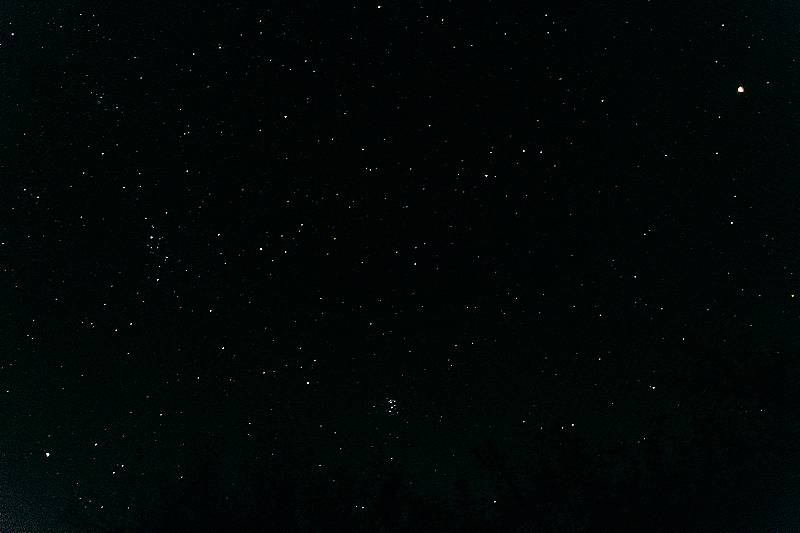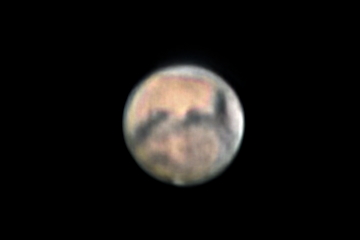D850/D7200/iPhone imaging:
Jupiter, Saturn, Mars, M31 & M33 galaxies
Posted: 14 October 2020
Monday, 12 October 2020, was clear but I did not open the observatory that night as I had an early morning commitment on Tuesday. Tuesday, 13 October, Mars reached "opposition", that point in its orbit where it is opposite the Sun as seen from the Earth. This means that the planet's disk is fully illuminated as seen from the Earth. 6 October 2020 was when Mars was closest to the Earth and so appeared slightly larger.
|
Open: Tuesday, 13 October 2020, 1810 MST Temperature: Clear°F |
Session: 1537 Conditions: 81 |
Equipment:
12" f/8 LX600 w/StarLock
2" 24mm UWA eyepiece
2" 5.5mm 100° eyepiece
2" 2X Powermate
2" 4X Powermate
1.25" 3X TeleXtender
Camera:
D850 DSLR
D7200 DLSR
iPhone 11 Pro Max
1815 MST: LX600 ON, StarLock OFF, High Precision OFF.
Viewed Jupiter and 4 moons, then Saturn and 1 moon, 102X
Next, prepared the D850 DSLR for prime focusing imaging of planets.
1827 MST: relaxed on the observatory patio bench while waiting for the sky to get darker.
1842 MST: the bright planet Mars at opposition was rising over the hill to the east.
1845 MST: back inside the observatory. Mounted the D850 DSLR at prime focus + 2X Powermate + 3X TeleXtender. This is a stack of 3616 video frames (1080p, 60fps) at 1/80sec, ISO 3200.

Slewed to Saturn and took this image, stack of 3615 video frames (1080p, 60fps) at 1/60sec, ISO 12800.

I then removed one of the finderscopes from the 12" telescope and mounted the D7200 DSLR piggyback on the 12" telescope using the ScopeStuff Camera Mount.
1926 MST: viewed M31 (Andromeda Galaxy), 102X. Nice view.
Slewed the 12" telescope to Mars and focused the D7200 DSLR, FL 18mm. Then slewed to the star Mirach, about halfway between M31 (Andromeda Galaxy) and M33 (Triangulum Galaxy). Did several framing test images at various focal lengths, 30 second exposures at ISO 25600. This is one of the focus tests at focal length 18mm. I thought it was rather neat with the trees and part of the StarLock refractor and 12" telescope in the field-of-view. Both galaxies are visible.

1956 MST: StarLock ON.
This is a StarLock autoguided, f/5, 5 minute, ISO 5000, FL 50mm, image showing M31 (Andromeda Galaxy) at the upper left, M33 (Triangulum Galazy) at the lower right, and NGC752 (open star cluster) at the lower left.

2015 MST: StarLock OFF.
Viewed Mars, 102X. Then took this piggyback D7200 DSLR photograph (f/8, 30 seconds, ISO 5000, FL 18mm) of the sky showing Mars at the center, with the StarLock and 12" telescope at the upper right.

2028 MST: ended piggyback imaging. Removed the camera and remounted the finderscope.
2034 MST: viewed Mars, 102X and 443X.
2036 MST: began relaxing on the bench while waiting for Mars to rise higher. From the bench I took two handheld iPhone 11 Pro Max photographs using the iOS Camera app (Night Mode, 10 seconds, 1X lens). The first one shows Cassiopeia Observatory with the constellation Cassiopeia above it, the constellation of Perseus, and the Double Cluster. The second photograph shows Cassiopeia (at the upper left) with the Pleiades (M45) at the bottom and Mars at the right. The third photograph was taken with the D7200 DSLR, handheld, f/3.5, 2 seconds, ISO 5000, FL 18mm, and shows the constellation of Perseus at the left, the Pleaides at the bottom, and Mars at the upper right.

Mouseover or tap on image for labels


2130 MST: mounted the iPhone 11 Pro Max on the Explore Scientific 5.5mm 100° eyepiece using the Levenhuk Smartphone Adapter. This is an afocal 443X image of Mars taken with the iOS app NightCap Camera (ISO 32, 1/120sec, 1X lens).

2145 MST: relaxed on the bench again while waiting for Mars to rise a little higher in the sky.
2215 MST: back inside the observatory. Mounted the D850 DSLR at prime focus + 2X Powermate + 3X TeleXtender. The first image of Mars is a stack of 3639 video frames (1080p, 60fps) at 1/250sec, ISO 3200. Then mounted the D850 DSLR at prime focus + 2X Powermate + 4X Powermate. The second image is a stack of 3624 video frames (1080p, 60fps) at 1/250sec, ISO 4000.


2248 MST: ended imaging.
Viewed Mars, 443X + Variable Polarizing Filters. As was also visible in the images above, the North Polar Hood, the South Polar Ice Cap, and Syrtis Major were all nicely visible. Lastly, viewed Mars, 102X. This ended my Mars at opposition viewing.
2304 MST: LX600 OFF.
Did a Sky Quality reading and reported the result to Globe at Night.
|
Close: Tuesday, 13 October 2020, 2320 MST Temperature: 73°F |
Session Length: 5h 10m Conditions: Clear, SQM 21.10 |
Comments are welcome using Email. Twitter users can use the button below to tweet this report to their followers. Thanks.
Cassiopeia Observatory Home Page
Copyright ©2020 Michael L. Weasner / mweasner@me.com
URL = http://www.weasner.com/co/Reports/2020/10/14/index.html
